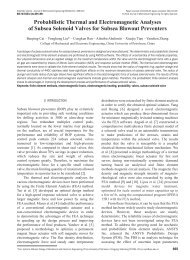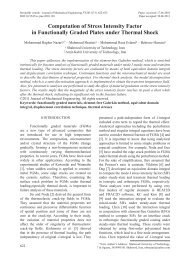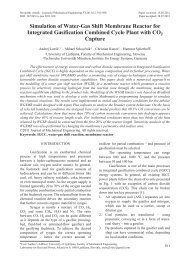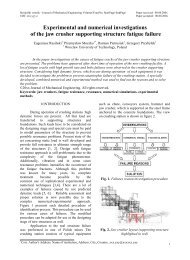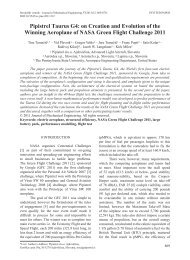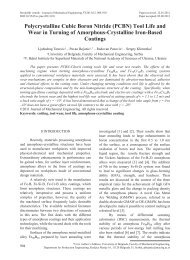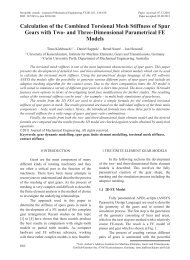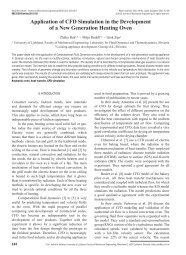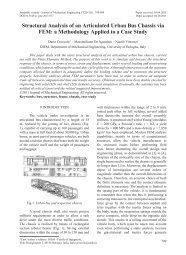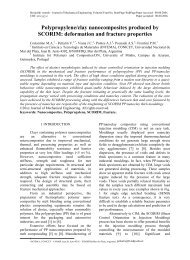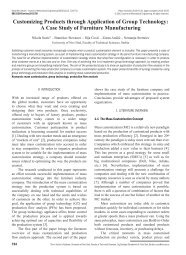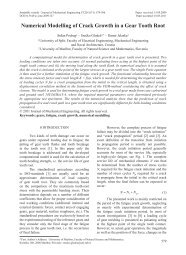Application of Promethee-Gaia Methodology in the Choice of ...
Application of Promethee-Gaia Methodology in the Choice of ...
Application of Promethee-Gaia Methodology in the Choice of ...
Create successful ePaper yourself
Turn your PDF publications into a flip-book with our unique Google optimized e-Paper software.
Strojniški vestnik - Journal <strong>of</strong> Mechanical Eng<strong>in</strong>eer<strong>in</strong>g 57(2011)10, 778-784<br />
<strong>of</strong> alternatives, from best to worst. At some<br />
o<strong>the</strong>r methods this is not <strong>the</strong> case, for example,<br />
<strong>the</strong> method <strong>of</strong> Elektra. Also, a clear graphical<br />
representation <strong>of</strong> alternatives and <strong>the</strong>ir values<br />
can be seen here and <strong>the</strong> decision maker does not<br />
have to go <strong>in</strong>to <strong>the</strong> text part, which usually seems<br />
annoy<strong>in</strong>g. What dist<strong>in</strong>guishes this particular<br />
methodology is <strong>the</strong> <strong>Gaia</strong>-plan alternatives and <strong>the</strong><br />
criteria, which clearly show <strong>the</strong> best alternative,<br />
and <strong>the</strong> alternative for which criterion is <strong>the</strong> best.<br />
1 THE PROMETHEE METHOD<br />
The PROMETHEE method is a<br />
multicriteria decision-mak<strong>in</strong>g method developed<br />
by Brans [3] and [4]. It is a rank<strong>in</strong>g method quite<br />
simple <strong>in</strong> conception and application compared<br />
to o<strong>the</strong>r methods for multi-criteria analysis. It is<br />
well adapted to problems where a f<strong>in</strong>ite number<br />
<strong>of</strong> alternative actions are to be ranked consider<strong>in</strong>g<br />
several, sometimes conflict<strong>in</strong>g, criteria [5] and [6].<br />
The PROMETHEE method is appropriate<br />
to treat <strong>the</strong> multi-criteria problem <strong>of</strong> <strong>the</strong> follow<strong>in</strong>g<br />
type:<br />
max{f 1 (a), ... , f n (a)|a \A}, (1)<br />
where A is a f<strong>in</strong>ite set <strong>of</strong> possible alternatives,<br />
and f j are n criteria to be maximized. For<br />
each alternative, f j (a) is an evaluation <strong>of</strong> this<br />
alternative. When we compare two alternatives a,<br />
b \ A, we must be able to express <strong>the</strong> result <strong>of</strong> <strong>the</strong>se<br />
comparisons <strong>in</strong> terms <strong>of</strong> preference. We, <strong>the</strong>refore,<br />
consider a preference function P. Let<br />
P(a, b) = F(d) = F[f (a) − f (b)], (2)<br />
0 ≤ P(a,b) ≤ 1, (3)<br />
be <strong>the</strong> preference function associated to <strong>the</strong><br />
criteria, where F(d) is a monotonically <strong>in</strong>creas<strong>in</strong>g<br />
function <strong>of</strong> <strong>the</strong> observed deviation (d) between<br />
f(a) and f(b). In order to facilitate <strong>the</strong> selection <strong>of</strong><br />
specific preference function, six basic types <strong>of</strong> this<br />
preference function are proposed to <strong>the</strong> decision<br />
maker, <strong>in</strong> each case no more than two parameters<br />
(thresholds q, p or s) have to be fixed [5] and [7].<br />
Indifference threshold q: <strong>the</strong> largest<br />
deviation to consider as negligible on that<br />
criterion. It is a small value with respect to <strong>the</strong><br />
scale <strong>of</strong> measurement.<br />
Preference threshold p: <strong>the</strong> smallest<br />
deviation to consider as decisive <strong>in</strong> <strong>the</strong> preference<br />
<strong>of</strong> one alternative over ano<strong>the</strong>r. It is a large value<br />
with respect to <strong>the</strong> scale <strong>of</strong> measurement.<br />
Gaussian threshold s: it is only used with<br />
<strong>the</strong> Gaussian preference function. It is usually<br />
fixed as an <strong>in</strong>termediate value between an<br />
<strong>in</strong>difference and a preference threshold.<br />
<strong>Prome<strong>the</strong>e</strong> permits <strong>the</strong> computation <strong>of</strong> <strong>the</strong><br />
follow<strong>in</strong>g quantities for alternatives a and b:<br />
a and b are alternatives from <strong>the</strong> first set <strong>of</strong><br />
alternatives A. Then is:<br />
k<br />
∑<br />
π ( ab , ) = P ( a, bw ) ,<br />
j=<br />
1<br />
k<br />
∑<br />
π (, ba) = P ( b, aw ) ,<br />
j=<br />
1<br />
j<br />
j<br />
j<br />
j<br />
(4)<br />
(5)<br />
• positive course <strong>of</strong> preferential (output<br />
course):<br />
Φ +<br />
= 1<br />
( a) ∑ π ( ax , ), (6)<br />
n − 1<br />
x∈A<br />
• negative course <strong>of</strong> preferential (<strong>in</strong>put course):<br />
Φ − = 1<br />
( a) ∑ π ( xa , ), (7)<br />
n − 1<br />
x∈A<br />
where w j are weights associated with criteria.<br />
For each alternative a, belong<strong>in</strong>g to <strong>the</strong> set<br />
A <strong>of</strong> alternatives, π(a,b) is an overall preference<br />
<strong>in</strong>dex <strong>of</strong> a over b. The leav<strong>in</strong>g flow Φ + (a) is <strong>the</strong><br />
measure <strong>of</strong> <strong>the</strong> outrank<strong>in</strong>g character <strong>of</strong> a (how<br />
a dom<strong>in</strong>ates all <strong>the</strong> o<strong>the</strong>r alternatives <strong>of</strong> A).<br />
Symmetrically, <strong>the</strong> enter<strong>in</strong>g flow Φ − (a) gives <strong>the</strong><br />
outranked character <strong>of</strong> a (how a is dom<strong>in</strong>ated by<br />
all <strong>the</strong> o<strong>the</strong>r alternatives <strong>of</strong> A). Φ(a) represents a<br />
value function, whereby a higher value reflects<br />
a higher attractiveness <strong>of</strong> alternative a. Φ(a) is<br />
called <strong>the</strong> net flow <strong>of</strong> alternative a [8]. All <strong>the</strong><br />
alternatives can be completely ranked (<strong>Prome<strong>the</strong>e</strong><br />
II) by net flow.<br />
The geometrical analysis for <strong>in</strong>teractive<br />
aid (<strong>Gaia</strong>) plane displays graphically <strong>the</strong><br />
relative position <strong>of</strong> <strong>the</strong> alternatives <strong>in</strong> terms <strong>of</strong><br />
contributions to <strong>the</strong> various criteria [8] and [9].<br />
1.1 The <strong>Prome<strong>the</strong>e</strong> & <strong>Gaia</strong> Analysis<br />
The purpose <strong>of</strong> this paper is not to expla<strong>in</strong><br />
<strong>in</strong> details <strong>the</strong> <strong>Prome<strong>the</strong>e</strong> methodology. See for<br />
<strong>in</strong>stance Brans [3] and [8]. Only <strong>the</strong> results<br />
<strong>Application</strong> <strong>of</strong> <strong>Prome<strong>the</strong>e</strong>-<strong>Gaia</strong> <strong>Methodology</strong> <strong>in</strong> <strong>the</strong> <strong>Choice</strong> <strong>of</strong> Systems for Dry<strong>in</strong>g Paltry-Seeds and Powder Materials<br />
779



